How to Avoid Talent Gaps with Data-Driven Succession Planning
People analytics enables you to create stronger succession plans. Learn how to avoid talent gaps with data-driven succession planning.

According to the Association for Talent Development, only 35% of organizations have a formalized succession planning process. This can be a risky proposition, especially if individuals in key roles are unexpectedly plucked out of your organization. These concerns can be heightened during times of crisis. As with most things, the best way to manage these risks is to be prepared and to have a plan.
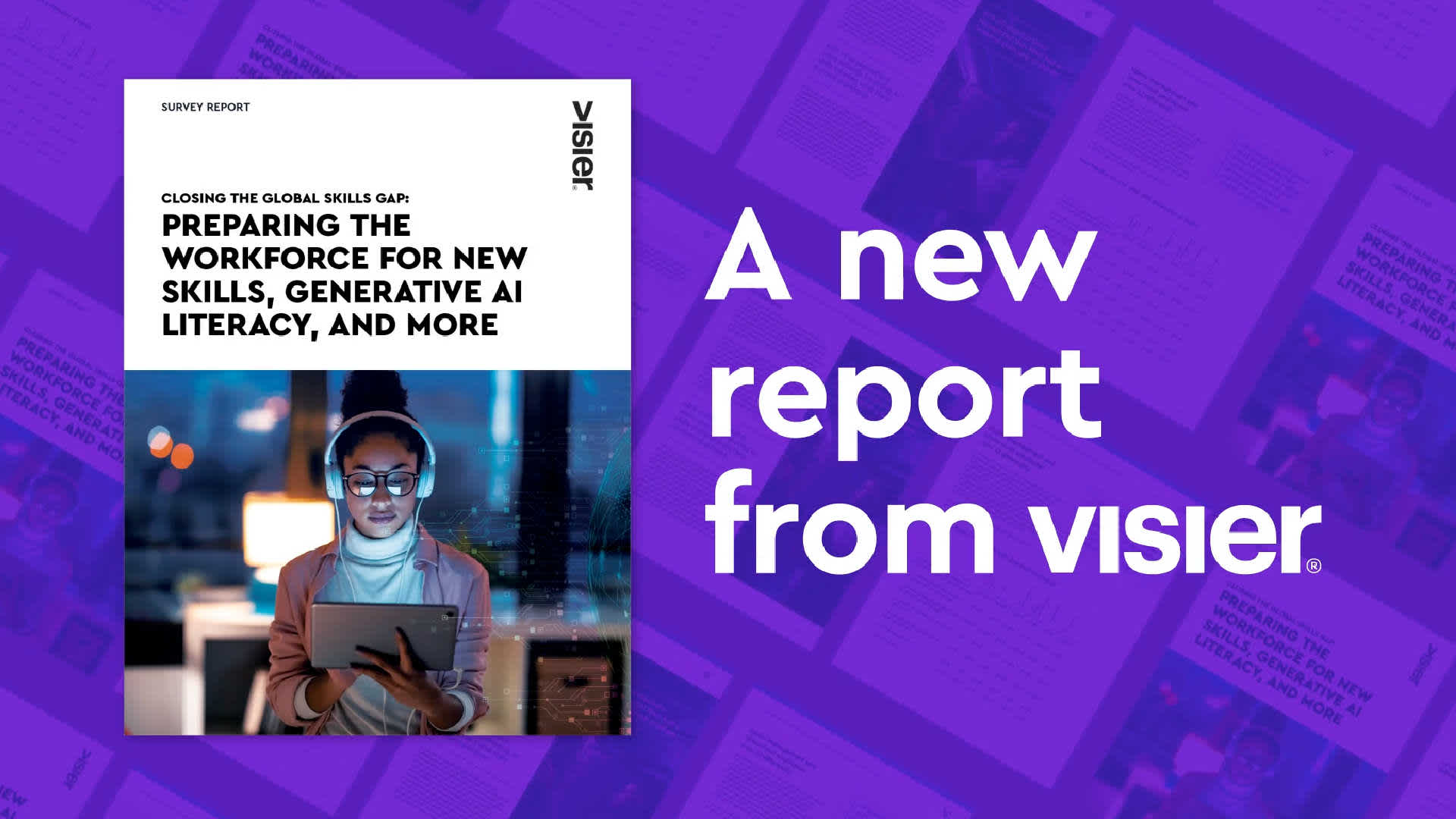
The trifecta of talent management tools for talent gap mitigation
There are three common talent management processes that, when managed effectively, significantly reduce potential risks associated with the loss of individuals in key or critical roles within the organization.
Succession planning: Identifying key positions and employees critical to the operation of the business and identifying successors able to step into these roles
Talent reviews: Structured evaluations of employees within the organization to assess the potential they possess to fit into future positions
Career pathing: Employee driven career management. Often, organizations provide tools that allow employees to explore opportunities and develop plans, set goals, and take action to proactively navigate their career.
Below, I outline different ways people analytics can be used to support these processes.
Succession planning with data
Having a succession plan is great, but how well do you understand the quality and strength of your plans? Analytics can help you evaluate:
Strength of your pipeline
What you need to answer: Do you have sufficient coverage for each of the key positions? Is there a retirement risk among the succession candidates on your slate?
The following analyses evaluate the strength of your candidate pool. Based on the analytics for this fictitious organization, it’s easy to see the size of the bench by position and the number of candidates ready now and over the next couple of years:

This analysis shows the size of the succession candidate pool by position and candidate readiness. Fictional data used.
Digging deeper can also show if the succession pool is viable over the long-term based on employees proximity to retirement:
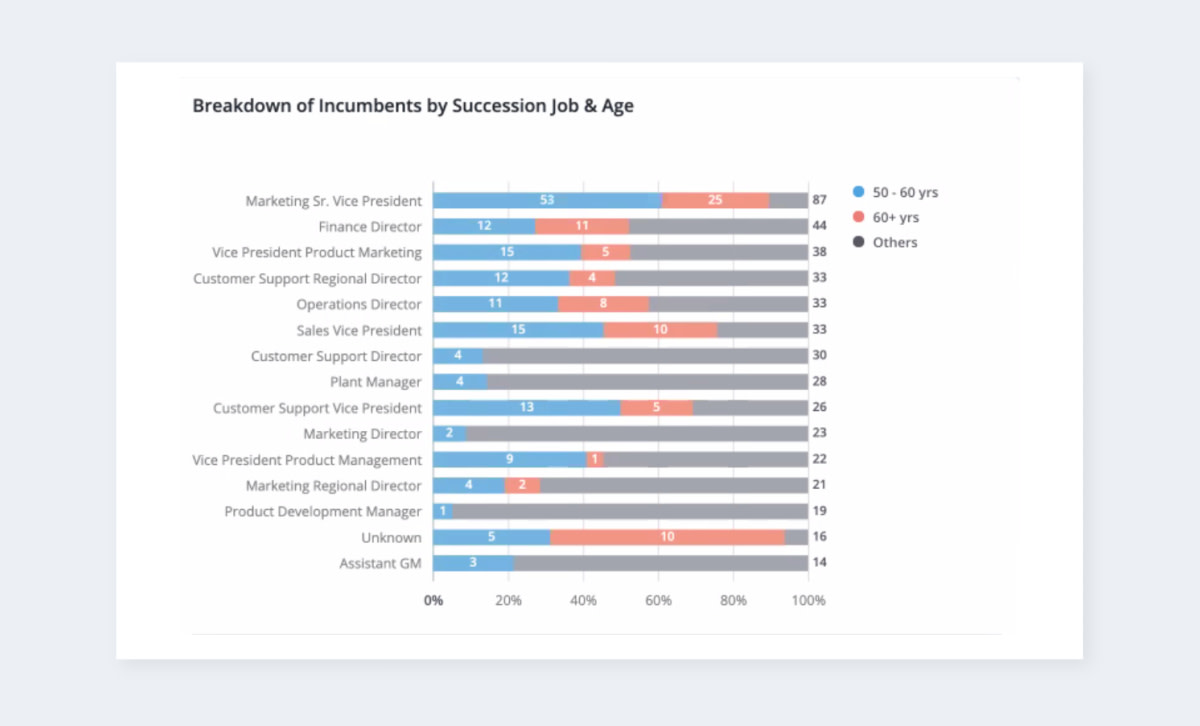
This analysis shows how close to retirement employees in the succession pool might be. Fictional data used.
Readiness progression of your talent
What you need to answer: Are your development plans effective? Are successors being promoted into succession positions?
This analysis helps you see if you are closing the readiness gaps over time. For example, if last year you had 150 candidates ready in two years, you would expect that this year there would be more candidates ready in one year. If not, there could be a greater focus applied to developing the skills, capabilities and experiences of these candidates to improve their readiness to take on increased responsibilities.

This visualization shows candidates readiness in the succession pool. Fictional data used.
Another important measure of the success of the program is how many ready now successors are moving into succession positions. If employees are ready to move into positions of greater responsibility, and are not seeing career progression, this may result in an increased risk of unwanted turnover.
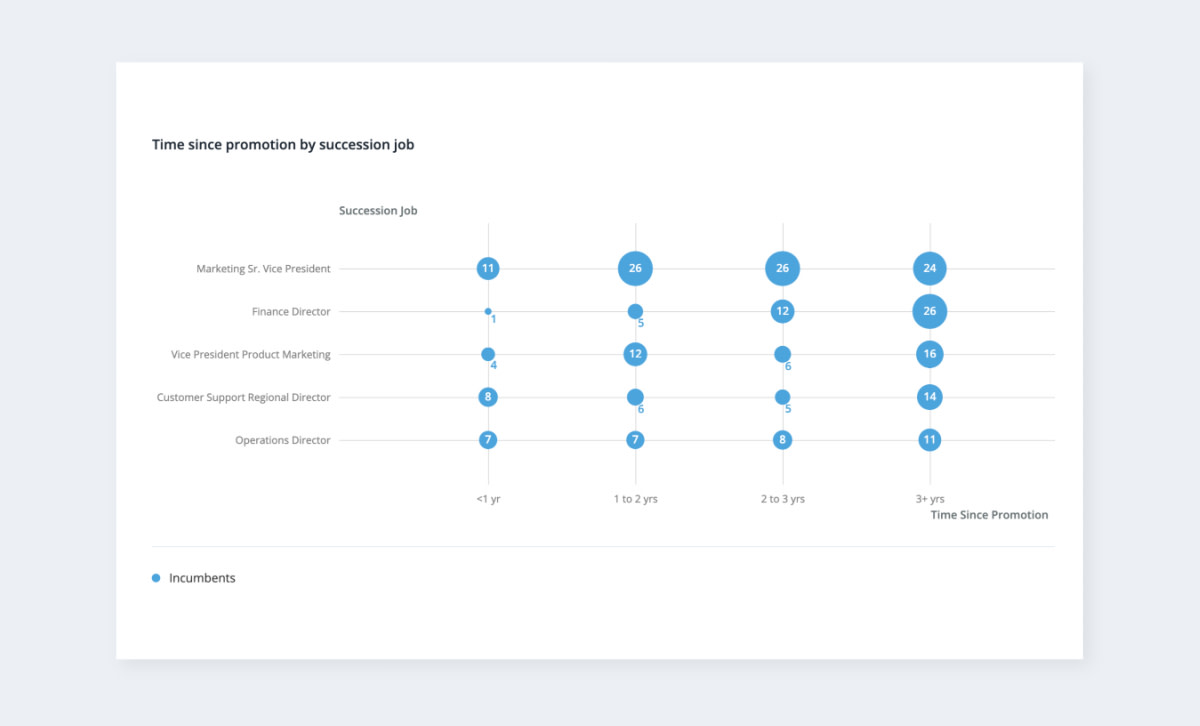
This analysis breaks down time since promotion by succession job. Fictional data used.
Diversity of your pipeline
What you need to answer: Will the current pipeline of succession candidates help you to achieve your diversity goals?
In the following examples, succession slates can be evaluated to determine the mix of employees from both a gender and minority employee perspective. This helps ensure that there is adequate representation to best position the organization to achieve diversity goals.

With this analysis, you see the mix of employees in the succession slate from a gender perspective. Fictional data used.
Additionally, the analyses below shows that while there seems to be a focus on gender diversity, candidate slates do not have strong ethnic diversity. This alerts you to an area that will need more focus.
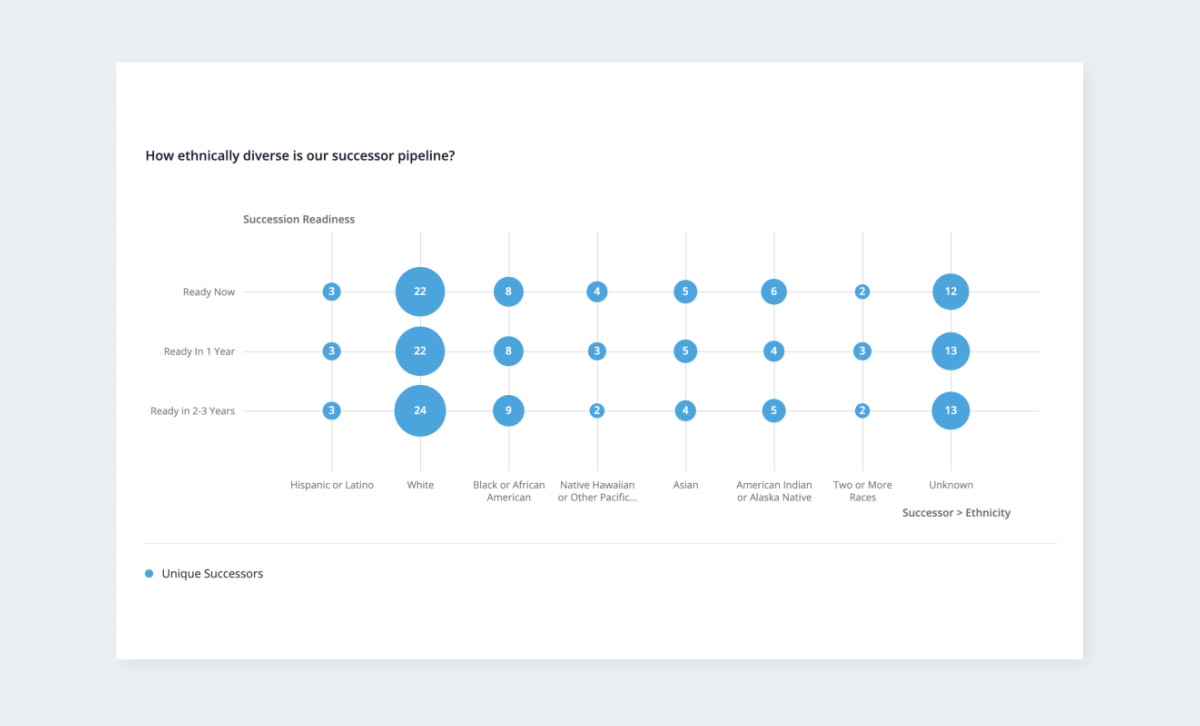
This visualization shows how ethnically diverse your succession pipeline is. Fictional data used.
Fact-based talent reviews
Most talent review participants are ill-prepared to discuss the performance and potential of employees. Analytics can help you have a more robust conversation about employee and organizational needs. For example, analytics allows you to:
Evaluate commitment of high potential talent
What you need to answer: Is a high performing employee a flight risk? How does he/she compare to others in the same job?
In this example, we compare Abbie to all other employees who hold the same position. When conducting a talent review, this internal benchmarking can be useful in determining where she sits against peers in a number of factors including pay, performance, tenure and risk of exit. Having all of this information at your fingertips can help develop more informed plans for both her development as well as approaches to retention strategies.

This comparison analysis shows where an employee sits against her peers for a number of factors. It’s useful in talent review. Fictional data used.
Identify what skill gaps may exist throughout the organization
What you need to answer: which areas are lacking key skills? Which employees possess these skills?
The examples below show that critical thinking skills are lacking organizationally. We can use analytics to surface which individuals have demonstrated these skills and/or if this is an organizational area of focus for development.

This analysis breaks down skills by department within a company, helping to surface where there may be skills gaps. Fictional data used.
Identify hidden talent
What you need to answer: Which employees are ‘off the radar’?
Leveraging organizational network analysis (ONA) helps you find your most active connectors and influencers in the organization. Our partner, TrustSphere, helps provide this type of analysis to show which employees others coalesce around and may indicate they make good leaders.
This type of analysis can be instrumental in helping to identify hidden leaders and people of influence within the organization. Identifying these individuals through patterns of connectivity can help reduce bias in the selection process and reveal employees who may be overlooked through a more traditional lens.
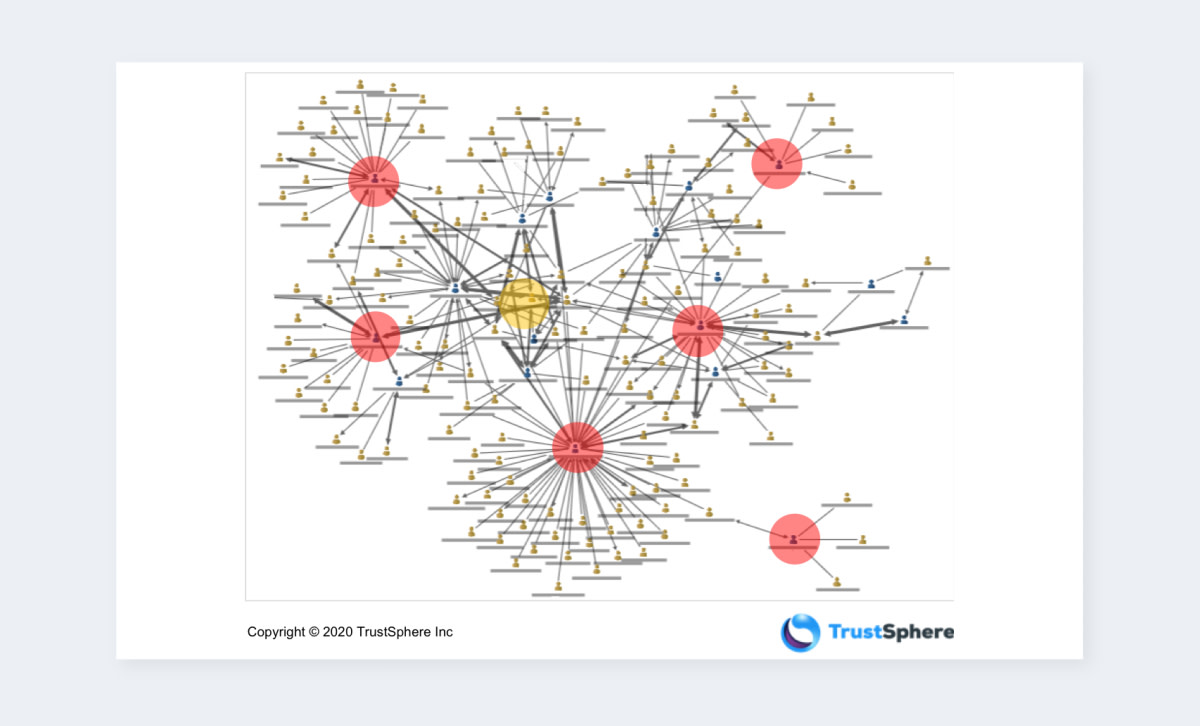
Example of an organizational network analysis from TrustSphere.
Data-driven career pathing
According to SHRM, “Employees usually feel more engaged when they believe that their employer is concerned about their growth and provides avenues to reach individual career goals while fulfilling the company’s mission.”
The challenge is that this can feel overwhelming without a clear picture of what opportunities are possible, limiting the abilities of both the manager and employee to have a meaningful conversation about career tracks other than vertical promotion.
To empower your people’s career mobility, you need to give your people managers the right tools. And not just ‘conversation-starters’ either, but hard data and easy-to-understand visualizations that can help managers and employees assess where they are and where they could go, producing a clear end-game for the pair to plan for.
The analysis below shows the different career paths that other employees have taken from the position Abbie currently occupies.
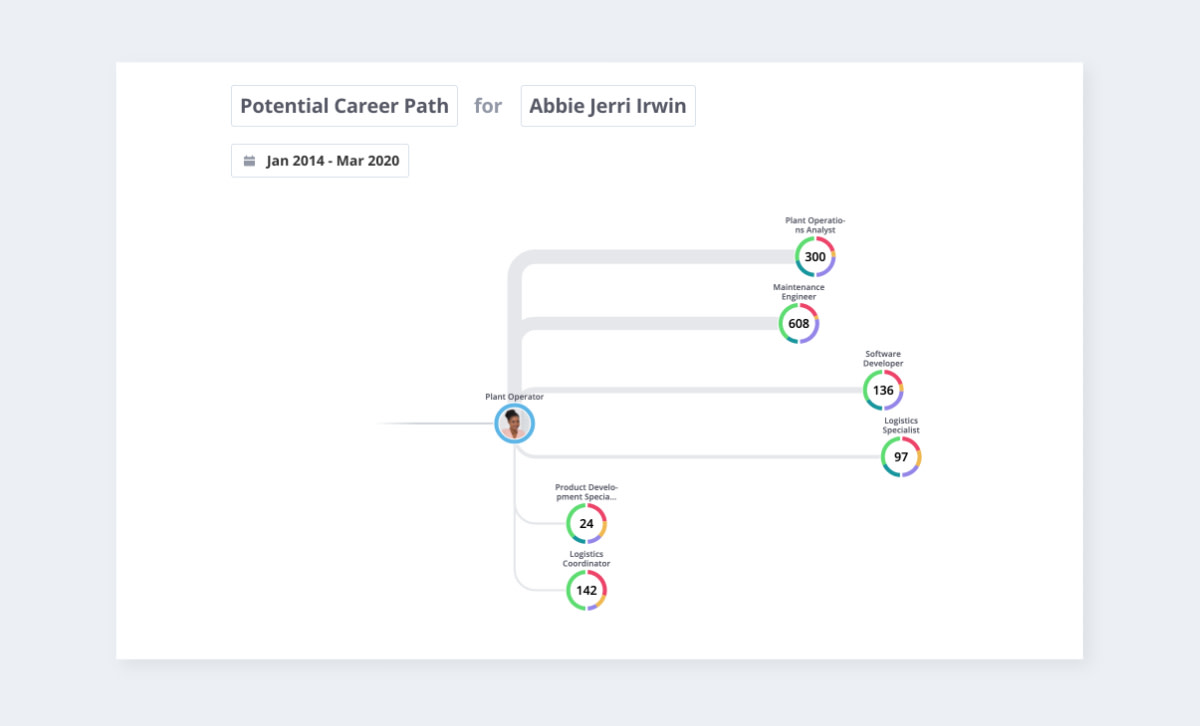
This career path shows the different jobs that other employees have taken that used to occupy Abbie’s role. Fictional data used.
We can also view tracks she can take to move to a position that might be her desired career goal:

Digging deeper into the career path analysis shows the different jobs Annie can take to achieve her goal job title. Fictional data used.
Bonus: How to use data to create supercharged succession plans during a crisis
In times of crisis, be sure to also evaluate the viability of succession candidates based on risk category, proximity to hot spots, and more. Things to consider are:
Which critical positions are empty or at risk of becoming empty
Which employee is in the right place to step in
Other staff who can act as mentors for those moving to new roles
Now that we know how people analytics supports the three tools of talent gap mitigation, here are three steps to using these processes to uncover good candidates:
1. Identify those ready to step into positions
If a succession plan does not exist, consider if the role needs to be filled immediately. Determine what should be defined as a critical position by evaluating both the importance of the role and how easy it is to train people for that role.
Ask questions like:
What is the cost of mistakes in this role?
How difficult is it to replace someone in this role?
How closely is this role tied to the success of our business success right now?
Once you’ve identified the positions to fill, analyze the career paths for these roles:
What other positions did these leaders have before?
Is someone in one of those positions now that has the ability to step into the vacated position?
Be sure to also factor in how departments have developed over time. When doing your analysis, be sure to factor out all other noise so you can focus only on critical roles at this time.
Consider which individuals have organizational dexterity. Use analytics to also surface individuals that have worked in several different functional areas successfully. Being able to identify people that have crossed the organization laterally, as opposed to horizontally is a big advantage as it enables you to identify agile people who are well-positioned to fill certain roles.
2. Start refilling your succession pipeline
Quickly shifting resources and priorities requires more agility. Once you’ve filled in your critical talent gaps, it’s time to replenish your succession well. Perform a skill analysis by looking through your skills and certification data and mapping these back to performance. You may also want to assess where your talent has come from, and what skills they bring to the table.
A skills analysis will also help you determine where you need to migrate resources. For example, you can figure out where it makes sense to move talent from high-risk areas to lower-risk areas. That way, you’re able to keep those individuals employed, but place them in different parts of the company based on what the demand is.
3. Provide training and mentorship
Short-term or temporary assignments will empower these next-in-line employees to showcase different skill sets and prepare them should that next unexpected employee exit occur. However, they may need some guidance.
Easy to access data will help you identify who held these roles before and connect them with the less experienced employees to help them bridge any skills and knowledge gaps. This makes it easier for employees who are stepping in to get up to speed fast.
Put your organization on the right path
Having plans in place to develop talent for key positions in your organization is essential. In times like these, succession planning and career pathing can help you avoid the risks associated with not having the right people in the right place at the right time.
It is essential to harness all of the tools and information available to unleash the power of your workforce. By laying a strong foundation, having strong and meaningful plans in place, and building analytics capabilities, you will definitely be ahead of the curve.
On the Outsmart blog, we write about workforce-related topics like what makes a good manager, how to reduce employee turnover, and reskilling employees. We also report on trending topics like ESG and EU CSRD requirements and preparing for a recession, and advise on HR best practices like how to create a strategic compensation strategy, metrics every CHRO should track, and connecting people data to business data. But if you really want to know the bread and butter of Visier, read our post about the benefits of people analytics.

Get Outsmart content straight to your inbox
Subscribe to the People Insights Monthly newsletter for actionable insights and stories.
Subscribe now